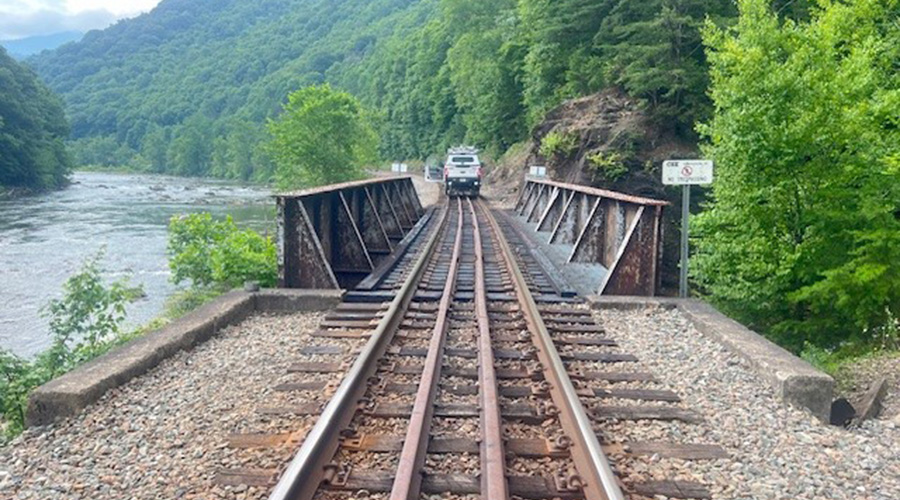Communication, collaboration and investment key to UP getting a bigger piece of the intermodal pie, Gosch says
1/14/2022
By Grace Connatser, Associate Editor
There are no boring days in Elise Gosch’s world. She stepped into her current position as Union Pacific Railroad’s assistant vice president of marketing and sales — premium intermodal on March 1, 2020, just weeks before COVID-19 gripped the supply chain.
In 2021, bottlenecks at ports led to shortages of many high-demand items, including raw materials and electronic components. Although the worst appears to be over — particularly at the ports of Los Angeles and Long Beach, where average container time spent at the docks fell nearly 84% between June and November 2021 — Gosch expects supply chain challenges to linger.
“I think we're going to see similar trends and the similar constraints into 2022 — for sure the first half, maybe the second half, we'll see,” she says. “On the ocean carrier side, the second half may bleed a little bit into 2023. A continued focus on improved velocity is our way to get more capacity in the marketplace. The faster [we are], the more capacity we can provide our customers to move more freight by rail.”
Stepping it up on the listening front
Gosch began her UP career in 2004 deploying technology for the intermodal sales team. Since then, she’s risen through the ranks, serving in 12 different roles in the marketing and sales department; the food team in field sales; the industrial and bulk teams in pricing; and in sales leadership at UP Distribution Services.
She was named senior director of commercial strategy and pricing in 2016, and general director of strategic planning and communications in 2019.
In her current role, Gosch leads a team of 22 sales representatives who call on intermodal shipping and transportation companies, big box retailers, ocean carriers and other pieces of the supply chain puzzle. The Class I’s premium intermodal program handles intermodal containers, finished vehicles and automotive parts. UP has more than more than 40 distribution centers located across the United States.
Her team is responsible for UP’s day-to-day freight movement operations and designing products and services based on customer need. Those needs can (and do) change, particularly during the past couple of years.
“What we're doing different this year than in the past is arming our sales team and our main customers with as much proactive communication as possible,” Gosch says.
For example, they’re talking with customers weekly, rather than monthly.
And while UP didn’t hire more sales representatives to manage rising demand as the pandemic pressed on, the railroad did “repurpose” people within Gosch’s department to improve communication with clients and partners, she says. Journey mapping the customer experience from the first mile to the last has been enlightening, she says.
"I do think from a shipper's perspective, through sharing and learning, you're seeing it — optionality will be key,” Gosch says. “And what I mean by that is having access to different routes that maybe we haven't traditionally.”
It’s about having access to different routes, different transportation modes, different carriers, even different manufacturing sites.
It’s also about communicating and cooperating with an array of supply-chain stakeholders, from terminal operators to Federal Railroad Administration officials to Surface Transportation Board representatives to members of the Biden administration’s Supply Chain Disruption Task Force.
“Union Pacific is definitely in a leadership position when it comes to addressing bottlenecks for the supply chain," Gosch says.
The intermodal value proposition
Given the revenue opportunities at stake, it’s crucial. In Q3 2021, the Class I reported $1.15 billion in intermodal revenue, an 8% increase compared with the total from the same 2020 period.
“Moving into intermodal provides a real value proposition to shippers, and for us, that means making sure that we continue to invest in a real product,” Gosch says. “That means we continue to listen to our customers and develop solutions.”
One solution: opening a new “pop-up” intermodal terminal at its West Colton rail yard that opened in May 2021 near the ports of Long Beach and Los Angeles. The terminal, which is a temporary structure as a “pop-up,” was strategically placed in one of the country’s fastest-growing industrial warehousing regions. The terminal helped “open new doors to places where people need to go,” Gosch says. UP has invested more than $1.6 billion in intermodal solutions since the early 2000s, according to the Class I’s website.
As for the supply chain: It’ll bounce back, Gosch promises — if, as she wrote in a September 2021 post on UP’s website titled “Supply Chain Challenges: We’re All in This Together,” everyone in the supply chain takes stock “of what they can control and use all available levers to address bottlenecks.”
For UP, it’s meant adding locomotives to the intermodal business to address network imbalances; reopened the railroad’s Global III ramp in Rochelle, Illinois, to use as an inland storage depot; and "bringing on new chassis in 2022 for the domestic pools which we manage and equipping our rail-owned containers with GPS units,” she wrote.
“We are collaborative, and we want to continue to do our part to improve,” Gosch says. “We're going to continue to invest and collaborate to make sure that we grow the intermodal pie.”


